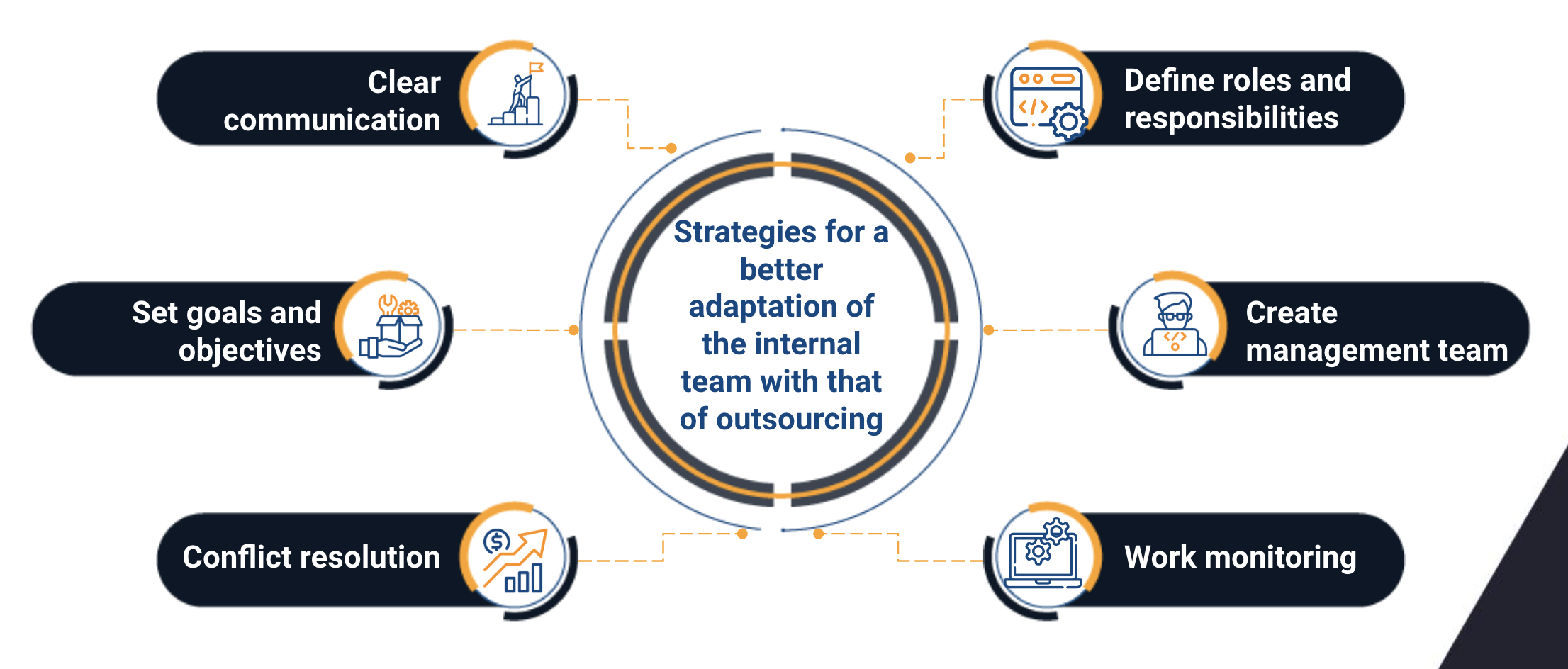
When a company decides to adopt the IT outsourcing modality, that is, to outsource certain functions and services related to information technology, it faces a process of adaptation of both its internal teams and external providers.
In the case of internal teams, adapting to the IT outsourcing modality implies a change in their role and focus, since they go from being directly responsible for outsourced tasks to becoming managers and supervisors of external providers. This requires a transition to a more relationship management-oriented mindset, where effective communication, constant monitoring, and clear goal setting are critical to ensuring that outsourced work is done efficiently and aligned with company goals.
On the other hand, providers of IT outsourcing services must also adapt to the dynamics of working with the client company. They must understand your needs, internal processes, and organizational culture to integrate effectively. In addition, it is essential that the outsourcing team has the right experience and skills to meet the expectations of the company and offer effective solutions to the technological challenges that arise.
In this article, we will precisely address the challenges that teams face and the strategies that will make this adaptation easier, both for the client's staff and for the IT outsourcing provider's staff.

Challenges of IT outsourcing in team management
Communication with the IT outsourcing team
The physical and cultural distance between internal and external teams can make communication difficult when working with the IT outsourcing service. Differences in language and time zones can lead to misunderstandings and response delays, affecting productivity and decision making.
“Accents can make English speakers in different parts of the world struggle to decipher each other's speech. What's more confusing, non-native speakers can fall for the sentence structure of their native language. Without an understanding of the colloquial language and jargon that can dominate exchanges between colleagues, misunderstandings can occur", they noted in an article on the CHRON portal.
Coordination and alignment
Maintaining proper alignment between the internal team and IT outsourcing providers can be tricky. Both teams must work in harmony to meet the objectives and vision of the company. Lack of alignment can lead to suboptimal results and conflicts.

Internal resistance
Some internal employees may feel threatened by IT outsourcing, fearing that their jobs will become expendable. The company must address these concerns transparently and show how outsourcing can benefit everyone by freeing up resources for more strategic tasks.
In a Computerworld article, they noted that workers who are disgruntled and concerned about changing responsibilities and fearing losing their jobs “can easily thwart projects” delegated to outside providers or services such as nearshore or offshore.
"Internal opposition is one of the main reasons why projects are not carried out", they added.
Managing the transition with the IT outsourcing team
Transitioning internal functions to an external team requires careful planning and execution to be as efficient as possible and not affect ongoing projects. The company must ensure that operational continuity is maintained and that new IT outsourcing teams have all the necessary information and resources.
Organizational culture
Integrating external teams into the company's organizational culture can be challenging, as different teams may have different ways of working and values, requiring adaptation to foster effective collaboration.
Possible loss of confidentiality
“This is perhaps the most dangerous problem that IT outsourcing poses. In this process, the companies involved must be able to trust each other implicitly, despite the contracts. However, there are unfortunate cases where this trust is breached, resulting in the loss of sensitive data and major security breaches. The parent company risks exposing itself to a lot of criticism in such cases, which can have a significant impact on the company's brand and sales", they stated in a LinkedIn article.
To overcome these challenges, proactive and efficient management, open communication, and strong strategic planning are essential. IT outsourcing can be successful when these challenges are adequately addressed and relationships of trust and collaboration are established between internal and external teams.

Strategies for teams to better adapt to the IT outsourcing modality
Clear and constant communication with the IT outsourcing team
Establishing effective communication channels between internal teams and IT outsourcing is crucial. Scheduling regular meetings to discuss progress, challenges, and expectations can go a long way. You can also use online collaboration tools and maintain open and transparent communication, to avoid misunderstandings and conflicts.
Define roles and responsibilities
Clarifying the roles and responsibilities of each team is essential to avoid overlaps and conflicts. Both the internal team and the IT outsourcing team need to have a clear understanding of their roles and how they complement each other.
Establish shared goals and objectives with the IT outsourcing team
Aligning the goals and objectives of both teams is essential to ensure that they work together towards a common result. Establishing clear metrics and KPIs allows you to measure performance and ensure that everyone is focused on the same results.

Create a relationship management team
Appointing a relationship management team that includes members from both internal and IT outsourcing teams can facilitate coordination and resolve issues more effectively. This team can act as a focal point for communication and decision making.
Resolve conflicts constructively
Disagreements and conflicts can arise in any employment relationship. The key is to approach them constructively and resolve them collaboratively, rather than letting them become obstacles to cooperation.

Do you need an IT outsourcing team? At Rootstack, we have +12 years of experience supporting companies in the development of their software projects. Contact us!

